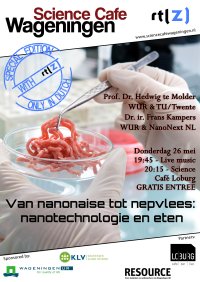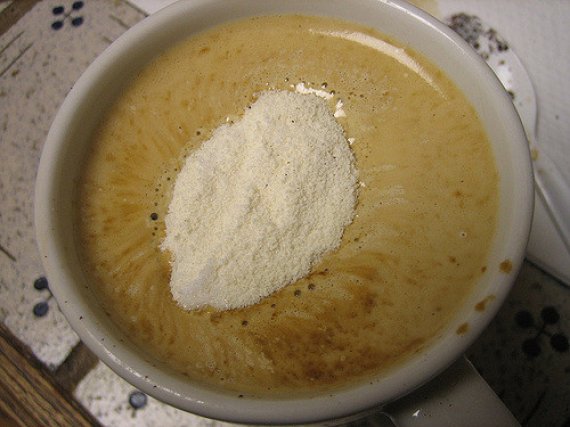Photo: Andrew Huff |
Coffee creamer does not coagulate thanks to a layer of nanoparticles
1. What is nanofood?
‘That is the wrong question,’ thinks Frans Kampers, coordinator at the Agrotechnology & Food Sciences Group (AFSG), ‘because all our food has a nanostructure. At the nano dimension, we mean structures ranging in size from 1 to 100 nanometres. To give you an idea how small that is, your nails grow at roughly 1 nanometre per second.’ Kampers believes the term ‘nanofood’ should be reserved for created structures that do not fall apart in the body. ‘Coffee creamer is an example. Normally this powder would form lumps, but thanks to a ‘layer of crumbs’ made of nano-sized silica particles it doesn’t.’

2. Is nanofood safe?
‘You need to make a distinction between nanoparticles that break down in the body into the chemical components from which they are built, and what are known as ‘persistent particles’ that retain their nanostructure. If nanoparticles remain intact in your body, this can have unpredictable results, over both the long and short term. This is because nanoparticles are often more reactive.’ From decades of use, we know that the nanosilica in coffee creamer is harmless, says Kampers. But the safety of new persistent nanoparticles should be demonstrated before a manufacturer can use them in any kind of food.
3. Can you give some examples of nanofoods people have made?
‘On the one hand you have synthetic nanostructures such as those being developed by Atze-Jan van der Goot for use in meat substitutes. He uses vegetable proteins to simulate the long meat fibres. On the other hand, you have synthetic nanoparticles that are often used to wrap up, as it were, certain substances. Iron or the fatty acids found in fish, for example, have an unpleasant taste. If you wrap them up, you don’t taste them in your mouth and the payload is released only once it reaches the gastrointestinal tract. And Karin Schroën has developed a nanoscale emulsion technology that makes it possible to replace some of the oil in a oil droplet with water. This means you can make nanonaise with less fat.’
4. Is nanotechnology in food good for us?
‘Yes, I am convinced it is. To make enriched foods for certain people with deficiencies, like sick seniors, you need nanotechnology. And without nanotechnology you can’t make good meat substitutes that are like the real thing.’ But if we eat a greener diet with lots of vegetables and fruit, don’t we achieve the same thing? ‘If everyone ate their five portions a day, we wouldn’t need this technology. But people don’t, and then nanotechnology can help.’
5. Do people know what nanofood is?
‘I don’t think so,’ replies Hedwig te Molder, professor of Strategic Communication at Wageningen University. ‘And this question is usually asked before proceeding to: Are they scared of it? Which brings us to one of the problems pertaining to technological development in food production: debate on the subject almost exclusively concerns the risks and benefits of a single piece of technology, like nanotechnology or genetic modification. While consumers have completely different questions about food. They find, for example, the industrialization of food production an important theme, and the taste of food – not to mention the fickle nature of scientific knowledge.’

